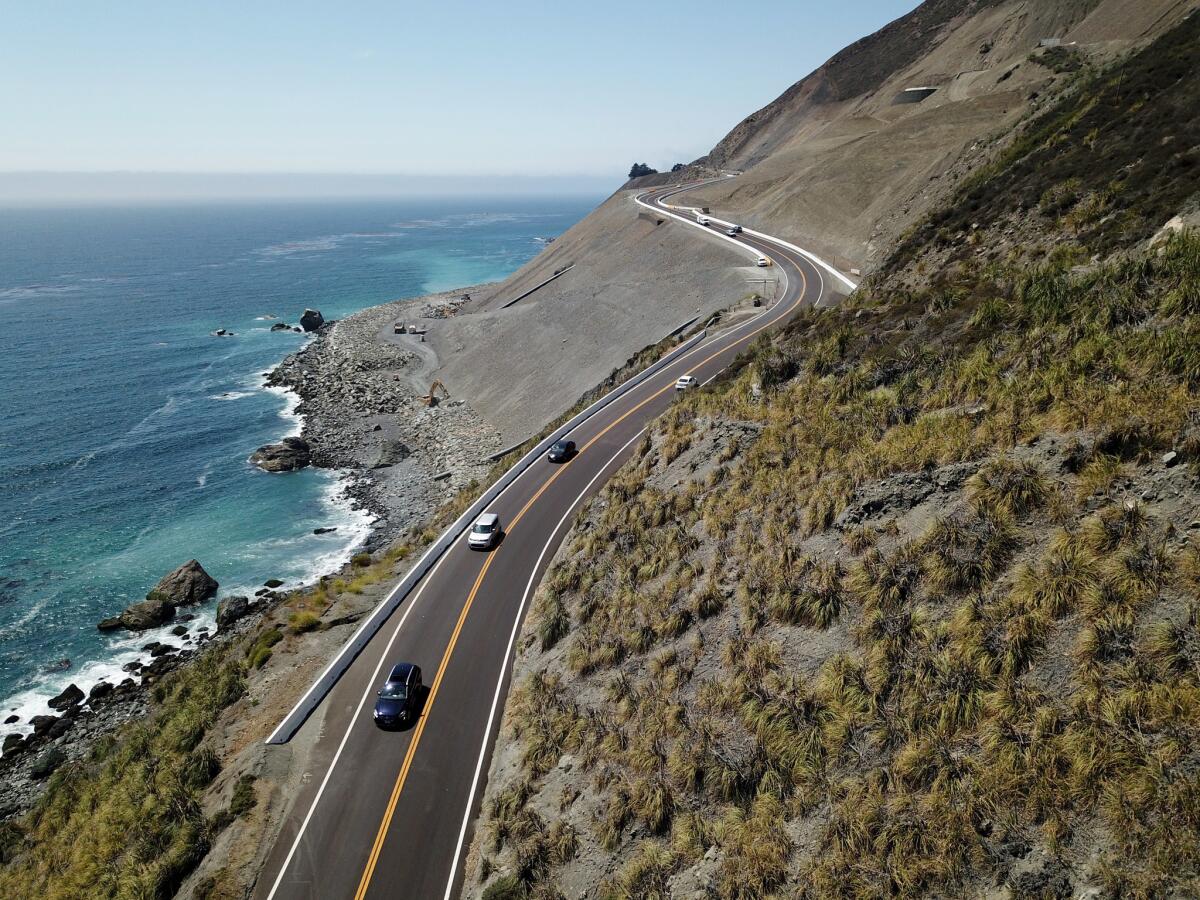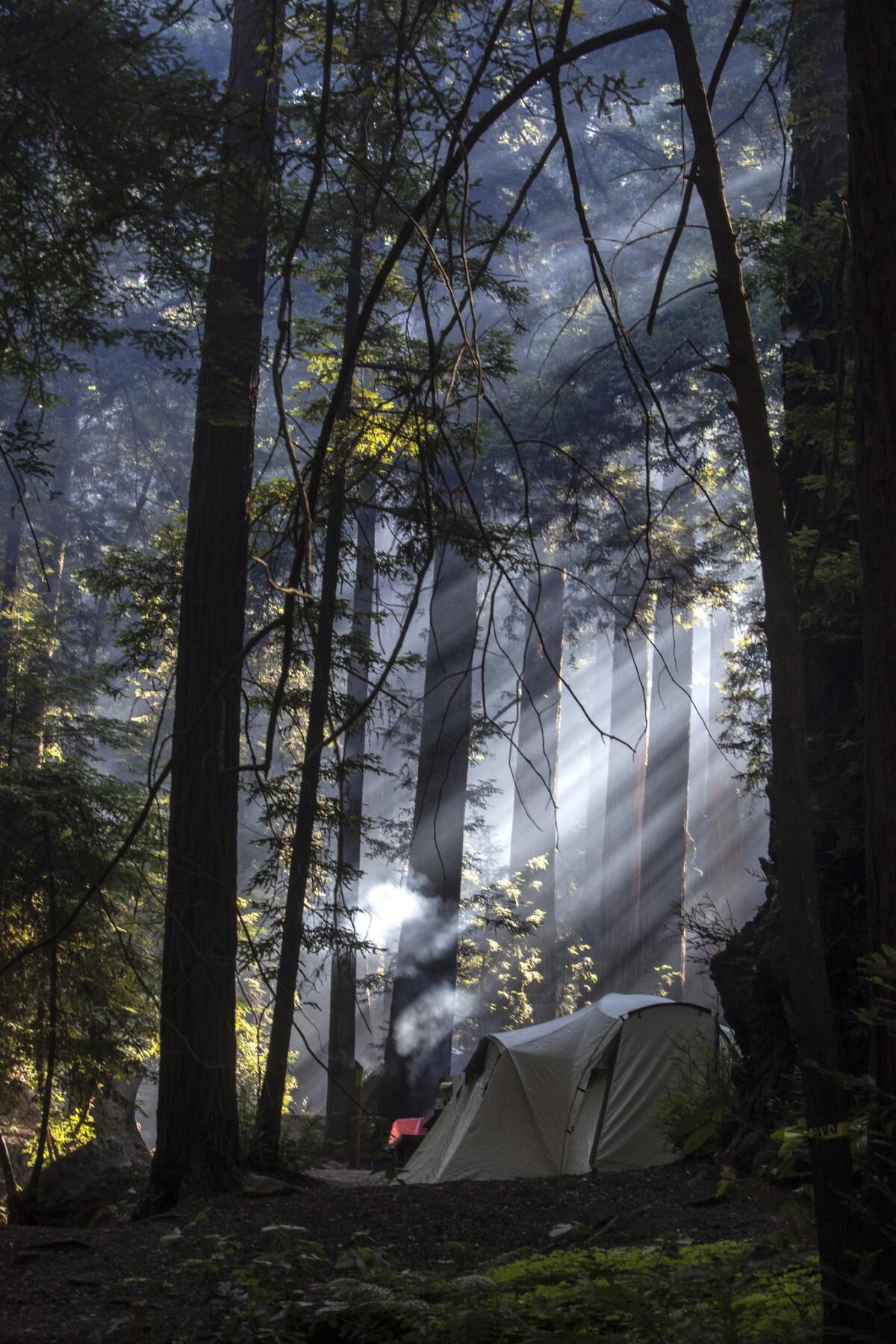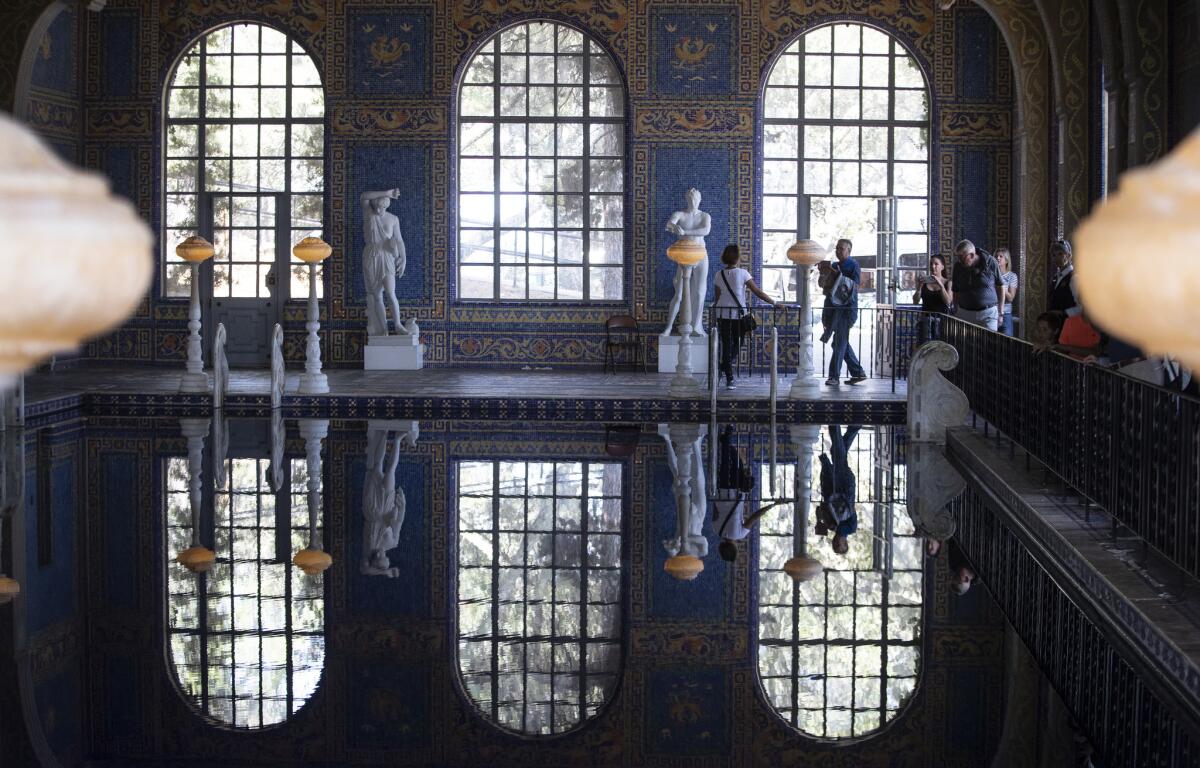With the reopening of California 1, Big Sur is back â and just in time

Fog-shrouded cliffs, chilly beaches, misty rainforests. That's Big Sur â California's wild slice of heaven less than a six-hour drive from L.A.
We lost this enchanted coastal Eden for nearly two years when fire, floods and landslides made access difficult. But it's back, and just in time. What could be better than a journey along California 1, the nation's premier scenic highway, while Southern California endures one of the hottest summers on record?
Earlier this month I escaped the sweltering temperatures and smoky skies of Los Angeles to drive the newly reopened Big Sur section of the highway, a 90-mile stretch of asphalt from San Simeon to Carmel. I saw windswept Monterey cypress trees, brilliant sunsets, giant redwoods and crashing surf along Pacific beaches.
The road, constructed by convicts in 1937, can be terrifying, but it's stunning all the same.The last few years have been difficult for Big Sur residents â and for travelers like me who crave the region's breathtaking scenery. The deadly Soberanes fire, which began in July 2016, burned for almost three months, destroying nearly 60 homes and more than 132,000 acres.
Heavy rains followed, causing flooding and landslides that resulted in the closure of Pfeiffer Canyon Bridge, the region's only connection to points north.
Residents had to hike out to shop for groceries and other necessities. There were no tourists for more than six months while the bridge was being rebuilt.
But the worst was yet to come. In May 2017 the largest recorded slide in Big Surâs history moved millions of tons of earth, covering more than a quarter mile of California 1 with 35 to 40 feet of dirt and rocks. The road would close for more than a year, with reopening taking place in mid-July.
The closure didn't just affect Big Sur businesses: From San Luis Obispo in the south to Carmel in the north, tourists disappeared.
In places such as San Simeon, home to Hearst Castle, hotels and restaurants struggled to stay in business. The same was true in Cambria, a pretty village that straddles a spectacular slice of coastline about 35 miles northwest of San Luis Obispo.
âBefore long, I was sailing around scary curves and looking for turnoffs so I could catch a better view of the panoramic vistas below.â

âEven though Cambria is south of the road closure, the blockage caused people to avoid driving Highway 1," said Maureen Hubble, who owns the city's Olallieberry Inn with husband Nelson. "People couldn't get through, so they just didn't come, especially foreign tourists.â
âWe're so happy that it's reopened," Nelson said. âYou can feel the energy in town.â
I could feel it too when I drove through on my way north. Cambria was bustling. At Old Cambria Marketplace, a combined gas station and store, a long line of cars snaked out to the street, everyone waiting to pay $4.29 to $4.69 a gallon for fuel.
I found prices high all along the route.
Farther north on California 1, for instance, I checked the rate for a room at the Motel 6 San Simeon: It was nearly $300 for that night, a Saturday. And at Ragged Point Inn & Resort, a motel complex with a stunning view of the southern Big Sur coast, I could barely find a place to park, and there were no vacancies.
A few miles north of Ragged Point, I passed the area where the Mud Creek Slide had closed the road; the repaired highway â a $54-million Caltrans project â is an engineering marvel. But I held my breath as I hurried by, happy that I hadn't been there when the mountainside slid down onto the road.
Before long, I was sailing around scary curves and looking for turnoffs so I could catch a better view of the panoramic vistas below. Many were packed with cars, not surprising given that it was summer and the road was finally open.
I managed to wedge my car into a spot at Julia Pfeiffer Burns State Park, a visitor favorite, and followed an easy trail to an overlook facing 80-foot-tall McWay Falls. The waterfall is a Big Sur landmark, dropping onto a sandy beach and bright blue-green bay.
An artist stood nearby sketching the scene as a crowd of about 20 people took selfies and scrambled to find a good perch to view the falls. I heard four languages being spoken at the overlook and a quartet of sea lions barking far below.
It was business as usual. Well, almost business as usual. Some trails and campgrounds at the park â and in other areas of Big Sur â are still closed because of the fires and slides, but most are open. (Check state park alerts).
I stopped next at the Hawthorne Gallery, a striking glass-and-steel building featuring local artists and a maze-like outdoor sculpture garden. Big Sur native Shelby Hawthorne was minding the store and took time to tell me about the eight long months when nearby Pfeiffer Canyon Bridge was closed.
On the plus side, "It was kind of a reset that was much needed for Big Sur residents," she said, explaining that there are usually so many cars and tourists on California 1 that life is hectic.
"We saw animals again, bunnies and mountain lions and coyotes. It was like nature had a chance to come back. That part was wonderful."
But it also meant 300 residents had no way to get out except by hiking a mile overland on a steep mountain trail to shop and go to school. âThat got old," she said. "After eight months, we needed access to the outside world again for everyone's well-being."
And they needed travelers to return, because many residents' livelihoods depend on tourism.
Some businesses, such as Ventana Big Sur, a 243-acre luxury resort, shut during the road closure, using the time to renovate. The $18-million project included refurbishing the hilltop hotel's 59 guest rooms and suites, transforming public areas and adding 15 safari-style tents in a redwood forest for guests who like to âglamp.â
The campsites are posh, with luxurious bedding, propane-powered fire pits and lovely forest views. But guests need to hike up a hill to the bathroom, just like real camping. And they'll be charged $650 or more a night for their âglampsiteâ if they visit this summer when rates are highest.
Ventana, like many other local businesses, was able to open after the Pfeiffer Canyon Bridge got an all-clear in October. But the visitors were coming only from Northern California and tended to visit just for the day.
The real difference occurred in July when the Mud Creek Slide was cleared, opening the road from the south.
"Weâve been swamped since the second part of the road opened," said Gladys Parada, Ventana's marketing manager. "I was aghast at the volume."

That could spell problems if you're planning on heading north anytime soon. I overheard a receptionist at a small B&B telling a caller that âsomething might open up in September.â
Thatâs the downside of visiting Big Sur: summer crowds, pricey accommodations and L.A.-style gridlock on the highway.
All three of these problems can be remedied off-season, however, when traffic thins and rates decrease. Whether you visit during the summer or off-season, allow enough time to see the regionâs highlights.
A leisurely drive takes about five hours, but you probably wonât be able to walk along a beach, dine at a funky Big Sur cafe or enjoy many other sights along the route if you lock yourself into that schedule.
You need time to get acquainted with Big Sur and its spectacular scenery. This seascape of ocean, beaches and forests is worth it, whether you're seeing it for the first time or the 40th.
What to see

Here are some places you shouldn't miss, traveling south to north on California 1:
Hearst Castle, San Simeon: If you haven't visited William Randolph Hearst's astonishing 115-room hillside mansion, this is your chance. From a staging area near California 1, buses will take you on a winding five-mile trip to the 127-acre estate and castle built by newspaperman Hearst in the early 1900s. (800) 444-4445.
Elephant Seal Landing and Piedras Blancas Light Station: These stops precede the ocean's-edge segment of California 1. Elephant Seal Landing is a quick stop five miles north of San Simeon; during the winter you'll see as many as 18,000 of the huge seals beached on the sand. Piedras Blancas Light Station,1590 Cabrillo Highway, San Simeon, offers morning tours several days a week.
State parks: At Julia Pfeiffer Burns State Park (its namesake was a lifelong Big Sur resident and rancher), take a short walk to stunning McWay Falls before continuing to Pfeiffer Big Sur State Park, where you can hike through the redwoods near the Big Sur River. If you have time, backtrack 1½ miles south on California 1 and turn right on the 2-mile Sycamore Canyon Road to wild and scenic Pfeiffer Beach, where the surf roars through arched rocks. When it's crowded, visitation is limited. I waited four hours before my car was allowed down to the beach.
Bixby Creek Bridge: Park at turnouts at the north end of this iconic bridge to take pictures of its single-span concrete arch. As you continue north, watch for sand dunes near Point Sur State Historic Park and Lighthouse, built in 1889. Tours are Saturdays, Sundays and Wednesdays at this state historic park.
Point Lobos State Natural Reserve: See tide pools, coves, headlands and meadows at this beautiful 550-acre park. Easy trails will take you along the sea's edge or to high cliffs overlooking the churning waters.
Warning: Take care where you leave your car. I got a $71 parking ticket at a Big Sur state park.
If you go
Where to stay
Ventana Big Sur, 48123 California 1, Big Sur; (831) 667-2331. High-season hotel rates from $1,200 per night, $750 fall and winter; glamping (luxury tent site) from $625, $350 low season. Tent-only camping at Ventana Campground from $85 a night.
Big Sur Lodge, 47225 California 1, Big Sur; (831) 667-3100. Mountain cabins in Pfeiffer Big Sur State Park with decks and forest or mountain views, some with kitchens. High-season rates from $309 per night, winter from $207.
Ragged Point Inn & Resort, 19019 California 1, Ragged Point; (805) 927-4502. Attractive 17-acre resort at the south end of the Big Sur coast, about an hour's drive from San Luis Obispo. Founded in the late 1950s, the inn has cliffside cabins, a dining room and fast-food outlet, market, gift shop and lots of hiking trails. Stop to admire the view, even if you don't spend the night. High-season rates from $214 per night, double occupancy; fall and winter rates start at $142 per night.
Carmel Valley Ranch, 1 Old Ranch Road, Carmel-by-the-Sea. 93923; (855) 687-726. Luxury resort at the north end of the Big Sur coast. Golf, wine tasting, hiking and swimming are available. High-season rates from $550 per night, fall and winter rates from $330.
Where to eat
Nepenthe, 48510 California 1, Big Sur; (831) 667-2345. This clifftop icon, probably the best-known business in Big Sur, survived the long business slump when the road was closed. You're paying for the view here â 808 feet above the sea â but it's worth it. Try Lolly's Roast Chicken, $32.25 (a Sunday dinner-style entree named for the original owner), or the Famous Ambrosiaburger, $18.25.
Deetjen's Big Sur Inn, 48865 California 1, Big Sur; (831) 667-2378. Breakfast at Deetjen's is a Big Sur tradition.Try the eggs Benedict or huevos rancheros, $13.50, or if you're on a budget, a single giant pancake for $5.
Big Sur Bakery and Restaurant, 47540 California 1, Big Sur; (831) 667-0520. Roadside coffee house and bakery offers sandwiches, burgers and breakfast in a garden setting. Try a burger for $20 or a chicken sandwich for $16.
To learn more
Produced by Denise Florez
Sign up for The Wild
Weâll help you find the best places to hike, bike and run, as well as the perfect silent spots for meditation and yoga.
You may occasionally receive promotional content from the Los Angeles Times.



